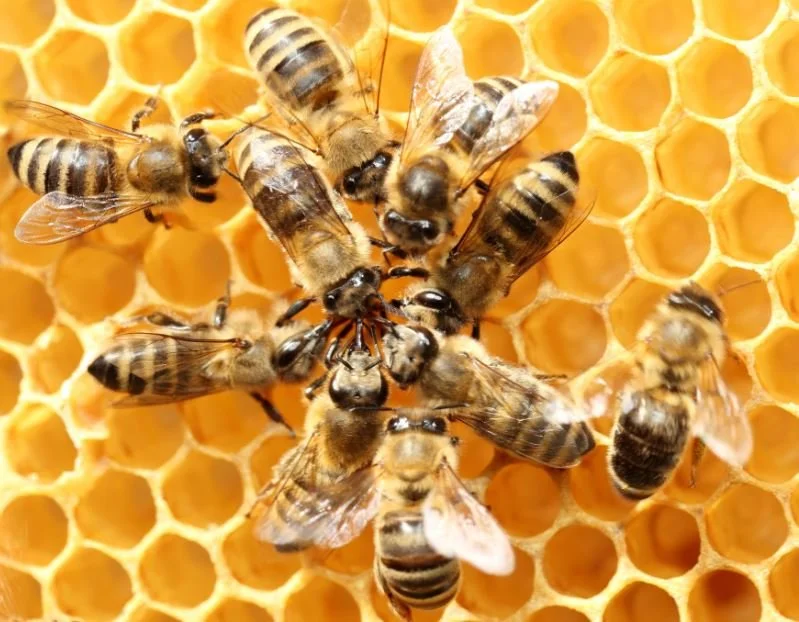2023—Year of the Bee
The prognosticators of food trends for the coming year are out in force. From journalists to influencers, everyone has an opinion of what will be the big thing in 2023, so I want to toss my two cents in the ring as a farmer, a market vendor, and a proponent for a better overall environment.
Bees. That’s right, everything bee. From personal hives to bee-based retail, people in the know are getting on board. As climate crisis looms heavily on us, many are asking what they can do to mitigate the environmental challenges we are all facing. As the old bumper sticker says: Think Globally, Act Locally.
Honey has been a staple at many of the markets’ fruit vendors as the need for pollinators is critical to the success of their crops. But I’ve also seen vegetable and flower growers adding hives to their operations given their need for pollinators as well. Even livestock farmers are adding hives to increase the productivity of their pastures.
Jars of golden nectar are the obvious products, but if you look closely, you’ll find honey throughout the market. As more people turn away from processed sweeteners and toward more natural ingredients you might be surprised where you find honey—in artisan drinks, baked goods, healthcare items, prepared foods, and adult libations.
Speaking of adult beverages, did you know there are six licensed meaderies in Maryland, including Clear Skies Meadery which you can find at Bethesda Central Farm Market? Evidence of mead production goes back as far as 9,000 and was most likely taking place long before recorded history and even agriculture. Ever heard of a honeymoon? Bee culture is prevalent throughout human history whether or not we realize it.
Beekeeping isn’t just for farmers. Hearing of colony collapse and loss of pollinator habitats individuals and non-farming related businesses have taken up either keeping hives or adopting pollinator-friendly practices such as eliminating the use of neonicotinoids, a class of pesticides deadly to bees. Pollinator gardens are springing are becoming popular. Did you know that honeybees travel up to three miles to collect pollen? You could be helping to support someone’s beehive without even knowing it.
For anyone willing to give beekeeping a try, there are lots of local resources available. DC Parks & Recreation, University of Maryland Extension, and Master Gardeners all have offered workshops in beekeeping. If you don’t want to amass all the equipment that goes with beekeeping, but would like to have hives, companies such as ALVÉOLE provide comprehensive apiary services to individuals, organizations, schools, and businesses.
Like all agrarian endeavors, beekeeping requires attention and has challenges. While many hobbyists mimic commercial beekeeping practices on a much smaller scale, Brenda Kiessling, a master beekeeper from Virginia who also keeps hives in Maryland advocates for a more natural way of keeping bees by replicating how bees would live in the wild. Books, such as The Lives of Bees: The Untold Story of the Honeybee in the Wild, by Thomas D. Seely, a retired Cornell University professor and the growing popularity of horizontal hives, also called Langstroth hives are drawing more people to beekeeping.
The Appalachian Beekeeping Collective is turning to apiary skills to help revive economically and environmentally distressed communities in West Virginia by teaching and supporting natural beekeeping.
Honeybees have been around for over a hundred million years going about their business of making honey, wax and propolis, a sticky, glue-like substance bees use to hold their hive together. Humans have been keeping bees for at least 5,000 years. Bee products have been worshipped, used to embalm the dead, used as an antibacterial agent for wounds and burns, skin and haircare, digestive aid, cough suppressant, for lubricants, glues, candles, molds, and even as currency. By far, my favorite thing about honeybees is that they dance and wiggle to communicate with each other. How cool is that! I’m just glad I had local honey on hand to sweeten my hot tea after doing chores in the brutal cold last week. Maybe I’ll get those hives I’ve been wanting built this year.

